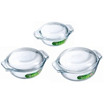Useful kitchen equipment
Alex and I always loved cooking and our kitchen was full of gadgets and utensils. However, when he developed dysphagia, I found the ones listed below most useful.
- Liquidiser. This was great for liquidising soups, smoothies, fruit cocktails etc as most goblets will take at least a pint (560ml)

- Kenwood Mini Chopper. I originally bought this for making pesto as it has a small capacity 350ml bowl. However, it proved invaluable for puréeing Alex’s meals – just the right size, easy to clean and store. It cost about £18 and I would highly recommend you invest in one if you do not already have one.

- Mini casserole dishes with lids / small plastic containers for refrigeration. Once puréed, a selection of these 250ml casserole dishes were most useful for storing and reheating Alex’s meals. Also, he did not mind eating out of them, so his food stayed warmer.

- Slow cooker. I would say an almost essential piece of equipment as any meat becomes very moist and tender when slow-cooked. I used it too for soups as, due to the very low simmer, no scum formed on the soup when using ingredients such as pearl barley.

- Hand blender. Again, a useful gadget for blending soups and sauces directly in saucepans – just take care with hot liquids and splashing the walls!

- Potato ricer. It looks like a giant garlic press. Do not buy one of these especially for your dysphagic patient. However, if you already have one, you know that it makes incredibly smooth mashed potato – far better than a conventional masher.

- Teaspoons and wide-diameter drinking straws. As discussed in "mouthful size" above, I found I could never have too many teaspoons or straws!
